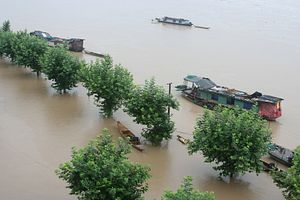Northern China is currently experiencing a severe drought. Xinhua reports that Henan Province, one of China’s top grain producers, has suffered economic losses of 7.3 billion renminbi ($1.2 billion) due to the drought, with agriculture representing 97 percent of those losses. Neighboring Hebei Province is also suffering, with rainfall levels in some areas at less than 50 percent of yearly averages. Liaoning Province, meanwhile, is in the midst of its worst drought since the province began keeping meteorological records in 1951.
Even as northern Chinese provinces dry up, southern China is experiencing devastating floods. In southwestern China, July flooding due to extreme rainfall killed at least 34 and caused 5.21 billion RMB ($839.8 million) in damages. In mid-July, Typhoon Rammasun, the largest to make landfall on China in 40 years, brought more rains and flooding. More recently, heavy rains have complicated efforts to rebuild after the August 3 Yunnan earthquake, and just this week more flooding in Guizhou province killed at least 12 people.
The droughts in the north and floods in the south may not be a coincidence, but part of a future trend caused by global climate change. The Intergovernmental Panel on Climate Change (IPCC)’s Fourth Assessment Report (issued in 2007) predicted an increase in extreme rains in western and southern China and a decrease in rainfall in the north. And changes in rainfall patterns are only one small part of the challenges climate change poses for China.
The IPCC’s Fifth Assessment Report, issued last year, predicts possible threats to both water and food security in China (and Asia in general) as well as more potential for natural disasters. Water supplies are threatened by glacial melting at the sources of both the Yangtze and the Yellow Rivers. With supplies dwindling even as water usage continues to increase, a water shortage is a real possibility. In turn, water scarcity will naturally affect the agricultural sector, which may see water shortages as early as the 2020s. Further threatening food security, IPCC predicts decreased grain yields as temperatures shift (although some regions in China may actually be able to increase their production).
Meanwhile, the IPCC warns that flooding will continue to pose a problem for China, and it’s not only rural villages that are at risk: the mega-cities of Guangdong, Shanghai, Tianjin, and Hong Kong are all listed as at-risk for coastal flooding. As for drought, IPCC predicts that annual economic losses due to drought will be between $1.1 and 1.7 billion in northeast China and cost around $900 million in north China — right in line with the $1.2 billion in losses Henan has experienced this year.
China is well aware of the difficulties posed by climate change. The State Council’s 2012 white paper on climate change began by noting that “China is one of the countries most vulnerable to the adverse impact of climate change.” As an example, the report cited the massive scale of the problem: “In 2011 alone, natural disasters affected 430 million people and caused direct economic losses of 309.6 billion yuan.” In 2011, China’s Second National Assessment Report on Climate Change Report reported that temperatures in China were actually rising faster than the global average. The report predicted that by the end of the century, China’s temperatures will rise by 2.5 degrees Celsius — and that’s in the best-case, low emissions scenario. With continued high emissions, temperatures could rise by 4.5 degrees.
Yet despite an awareness of the issues, China (like most countries around the world), is having trouble finding solutions. Certainly the threat lends increased urgency to Beijing’s attempts to cut emissions and move to clean energy sources. However, even drastic emissions cuts cannot prevent the damage already done by past emissions, which will continue to drive global climate change patterns. Last December, China’s National Development and Reform Commission issued a report warning that China was ill-equipped to deal with the effects from climate change. “Our country is a developing nation with a large population, complex climate conditions and a weak environment (situation),” the report said, as quoted by Reuters. “The mission to deal with climate change is very arduous, but knowledge in society and ability to do this are weak across the board.”
The problem of mitigating global climate change is exacerbated by China’s already-substantial environmental issues. The IPCC’s latest assessment pointed out that the effects from climate do not occur in a vacuum — rather, climate change will serve to compound “multiple stresses caused by rapid urbanization, industrialization and economic development.” China has these “stresses” in spades, and now faces the herculean challenge of both repairing damage that has already been done and shifting practices (particularly water usage and agricultural techniques) to attempt to mitigate future threats.

































